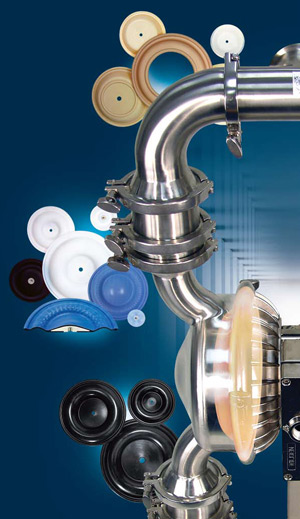|
|
|
Wilden Diapragm Options
Thermoplastic Elastomer (TPE)
- WIL-FLEX: Made of Santoprene, this diaphragm is available in an FDA compliant version and is an excellent choice as a low cost alternative to PTFE in many acidic and caustic applications, such as sodium hydroxide, sulfuric or hydrochloric acids. Wil-flex exhibits excellent abrasion resistance and durability at a cost comparable to neoprene.
- SANIFLEX: Made of Hytrel, this FDA compliant diaphragm exhibits excellent abrasion resistance, flex life and durability. This material is designed for food processing applications and is an outstanding general purpose diaphragm as well.
- POLYURETHANE: An excellent general purpose non-food grade diaphragm for use in non-aggressive applications. This material exhibits exceptional flex life and durability. This is Wilden's most economical diaphragm.
PTFE Elastomers
- PTFE: Both FDA and USP Class VI compliant, PTFE is an excellent choice when pumping highly aggressive fluids such as aromatic or chlorinated hydrocarbons, acids, caustics, ketones and acetates. Wilden's PTFE diaphragms exhibit good flex life.
- Wilden also offers PTFE integral piston diaphragms and PTFE laminate diaphragms that offer superior product containment. The smooth contoured shape makes this diaphragm an excellent choice for sanitary, ultra-pure, or CIP applications.
Ultra-Flex Diaphragm Technology
- Guaranteed longer life – If longer life is not experienced, Wilden will send you a new set of Ultra-Flex diaphragms free of charge.
- Convolute shape, altered fabric placement, and unique hardware work together to decrease the unit loading on the diaphragm and distribute stress.
- Material Options: Buna-N (FDA), EPDM (FDA), Viton, Neoprene
Rubber Elastomers
- BUNA-N: Excellent for applications involving basic food products and those containing fat and oil.
- EPDM / NORDEL: Excellent for use in applications requiring extremely cold temperatures. EPDM may also be used as a low-cost alternative for pumping dilute acids or caustics.
- VITON: Is excellent for use in applications requiring high temperatures. Viton may also be used in aggressive fluids such as aromatic or chlorinated hydrocarbons and acids. PTFE would normally be used with these aggressive fluids, however, in applications involving suction lift outside the range of PTFE, Viton will be the preferred choice.
- NEOPRENE: Is an excellent general purpose diaphragm for use in non-aggressive applications such as water-based slurries, well water, or sea water. Exhibits excellent flex life and low cost.
Elastomer Temperature Limits
- NEOPRENE: -17.7°C to 93.3°C (0°F to 200°F)
- BUNA-N: -12.2°C to 82.2°C (10°F to 180°F)
- EPDM / NORDEL: -51.1°C to 137.8°C (-60°F to 280°F)
- VITON: -40°C to 176.7°C (-40°F to 350°F)
- WIL-FLEX: -40°C to 107.2°C (-40°F to 225°F)
- SANIFLEX: -28.9°C to 104.4°C (-20°F to 220°F)
- POLYURETHANE: -12.2°C to 65.6°C (10°F to 150°F)
- PTFE: 4.4°C to 104.4°C (40°F to 220°F) for constant use
- PTFE: Up to 130°C (250°F) for temporary CIP and SIP exposure
Diaphragm Considerations
- Flex Life
- Chemical Resistance
- Temperature Limitations
- Abrasion Resistance
- Initial Cost
|
|
Hours of Operation:
Monday – Friday, 8:30 a.m. – 5 p.m. EST
|
| |



